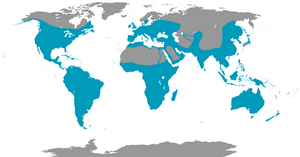Coraciiformes facts for kids
Quick facts for kids Coraciiformes |
|
|---|---|
 |
|
| European Roller Coracias garrulus |
|
| Scientific classification | |
| Kingdom: | |
| Phylum: | |
| Class: | |
| Infraclass: | |
| Order: |
Coraciiformes
Forbes, 1884
|
 |
|
| Global distribution of the Kingfisher and allies | |
The Coraciiformes are a special group of birds known for their bright colors. They are often called "near passerines," which means they are related to songbirds but are not true songbirds themselves. This order includes many interesting birds like kingfishers, hoopoes, bee-eaters, rollers, and hornbills.
Contents
Meet the Coraciiformes Birds
This bird group is famous for its amazing colors and unique features. Many of these birds live in warmer parts of the world. They have adapted to different environments, from forests to deserts.
What Makes Them Special?
Coraciiformes birds often have a unique foot structure called syndactyly. This means two or three of their front toes are joined together at the base. Imagine having your third and fourth toes fused! This can help them perch or dig. However, some kingfishers might even be missing one of these toes.
Where Do They Live?
Most Coraciiformes birds live in the "Old World." This term refers to continents like Europe, Asia, and Africa. Only a few types are found in the "New World," which includes North America and South America.
Old World Residents
- Kingfishers: There are over 90 species of kingfishers. Many are known for diving headfirst into water to catch fish. They often have bright blue, green, or orange feathers.
- Rollers: These birds are named for their amazing aerial displays during courtship. They tumble and roll in the air! Rollers are very colorful, with shades of blue, purple, and brown.
- Bee-eaters: As their name suggests, these birds love to eat insects, especially bees and wasps. They are very skilled at catching them in mid-air. Bee-eaters are also very colorful, often with green, blue, and yellow feathers.
- Hoopoes: The hoopoe is easily recognized by its unique "crown" of feathers on its head. It also has a long, curved beak perfect for digging insects out of the ground.
- Hornbills: These large birds are known for their huge, often colorful, beaks. Some hornbills have a special structure on top of their beak called a "casque." They live in forests and eat fruits, insects, and small animals.
New World Residents
- Todies: These small, bright green birds are found only in the Caribbean islands. They have short tails and long, flat beaks. Todies mainly eat insects.
- Motmots: Motmots live in the forests of Central and South America. They are known for their unique tail feathers, which often have bare shafts with a racket-like tip. They eat insects, fruits, and small reptiles.
Images for kids
See also




